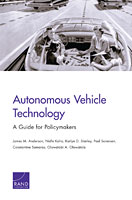As policy makers are waking up to the potential and issues related autonomous vehicle technology, the US think tank RAND Corporation has released a comprehensive report which analyzes driverless car technology from a policy perspective. The report looks at costs and benefits, the state of the technology, current legislation, liability and concludes with recommendations for policy makers.
The report wavers between more incremental, functional perspectives (where autonomous technology is seen as an incremental improvement of current cars with little change to patterns of car use and ownership) and transformational perspectives (transformation of mobility, fully autonomous vehicles, fleets of driverless taxis). On one hand, the authors point out that the technology may enable developing countries to “leapfrog autonomous vehicle technology” and “skip some aspects of conventional, human-driver centered travel infrastructure”. They point out that much urban space may be freed up because much fewer parking space is needed when fleets of self-driving cars provide mobility services (which actually may increase the density of urban centers) and argue that the declining costs of mobility may increase the number of vehicles miles traveled.
On the other hand, they warn that the adoption of self-driving car technology could be hindered because the individual car owner does not profit sufficiently from the reduction in external costs of the technology (an argument that seems quite far-fetched) and fail to point out the obvious incompatibility of new regulations that would impose the “Irrebuttable presumption of driver control of vehicle” with fully autonomous mobility services. While the report warns about job losses in the transportation industry, they neither mention the risks for the auto industry nor their potential lack of incentives for deploying fully autonomous vehicles.
In the same vein, the sections on liability are mostly focused on the various alternatives of assigning liability to either the driver or the automotive manufacturer. The car’s owner and entity responsible for maintenance is not seen as another alternative. Neither are the additional concerns addressed that may arise when autonomous fleets are operated by mobility service providers.
The study is an excellent read and brings together many important aspects of autonomous vehicles. For those interested in the legal issues it also contains a good discussion of the theories of liability which are relevant in the United States. As their final conclusion, the authors recommend that policy makers let the technology evolve and abstain from premature regulation.

